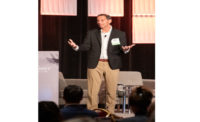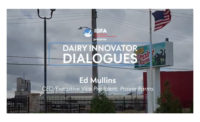Dairy industry leaders joined hunger relief organizations from across the Midwest on June 22 to 24 met in Kansas City, Kan., to exchange ideas and discuss business models that will help get more dairy into the hands of people experiencing food insecurity during the Dairy Nourishes America Midwest Symposium, which was organized by Feeding America, Dairy Farmers of America (DFA) and the Innovation Center for U.S. Dairy.
Members of 32 Feeding America network food banks from 15 states joined representatives of dairy processors, refrigeration companies, National Milk Producers Federation, U.S Department of Agriculture (USDA) and others to address solutions to provide more dairy to people in need. Feeding America reports – on average – a person seeking assistance from food banks receives less than a gallon of milk a year, yet it remains among the most requested items among the 38 million Americans facing hunger.
Barb O’Brien, CEO and president of Dairy Management Inc. and the Innovation Center for U.S. Dairy, pointed to the steady growth of dairy products moving through Feeding America, a checkoff partner, over the years. Industry efforts, including from local and national checkoff teams, cooperatives, processors and USDA, helped grow the amount of dairy distributed from 446 million pounds in 2019 to 664 million in 2021, according to Feeding America data.
O’Brien said the Innovation Center’s food security taskforce, led by DFA executive Jackie Klippenstein and retired Kroger executive Erin Sharp, is working to rally the industry to distribute 1 billion pounds of dairy annually by 2025.
“It’s ambitious but achievable,” O’Brien said. “If we work together, we can address those gaps and opportunities like transportation, cold storage and other infrastructure challenges that we know exist. ... No child or individual within one of the most food-secure nations in the world should go hungry or lack access to the affordable, unmatched nutrition that dairy provides.”
Jerod Matthews, who serves as Feeding America’s senior director of dairy product resourcing, said increasing access to more dairy requires a new business model that doesn’t simply count on donations.
“Feeding America is looking for innovative ways to access food donations from across the supply chain,” Matthews said. “As companies increase efficiencies, less product remains available for donation. We need strong public/private partnerships in order to continue providing food assistance to the tens of millions of people turning to the charitable food sector for help.”
U.S. Secretary of Agriculture Tom Vilsack referenced USDA programs that have addressed hunger and made dairy available. He pointed to more than $39 million in grants through the agency’s Emergency Food Assistance Program to support low-income and underserved communities, including expanding warehouse and refrigeration capacity in food banks. Vilsack also spoke of the $400 million Dairy Donation Program where dairy organizations partner with food banks to facilitate donations and reduce food waste.
“I look forward to hearing more ideas about how we can work together to make certain that no American goes to bed malnourished,” Vilsack said. “When organizations like Feeding America host meetings like this one and develop private sector efforts, our country comes closer to finding meaningful and sustainable solutions.”
The meeting also featured expert speakers, including Dr. Chris Cifelli, senior vice president of nutrition research for National Dairy Council (NDC). Cifelli emphasized how dairy can help people meet their nutritional needs, saying an NDC-led study used a computerized analysis of the nutrition data of foods and examined what would happen if dairy was eliminated from the diet.
“We ran numerous simulations, and it turned out that dairy is extremely difficult to replace,” Cifelli said. “Yes, you can try to replace milk but there are tradeoffs. You’re going to have to eat more food and consume more calories and you’re going to have to pay more and that’s something consumers may not want to consider.”



